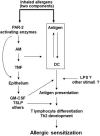Protease-activated receptor-2: Role in asthma pathogenesis and utility as a biomarker of disease severity
- PMID: 35966869
- PMCID: PMC9372307
- DOI: 10.3389/fmed.2022.954990
Protease-activated receptor-2: Role in asthma pathogenesis and utility as a biomarker of disease severity
Abstract
PAR2, a receptor activated by serine proteases, has primarily pro-inflammatory roles in the airways and may play a role in asthma pathogenesis. PAR2 exerts its effects in the lungs through activation of a variety of airway cells, but also activation of circulating immune cells. There is evidence that PAR2 expression increases in asthma and other inflammatory diseases, although the regulation of PAR2 expression is not fully understood. Here we review the available literature on the potential role of PAR2 in asthma pathogenesis and propose a model of PAR2-mediated development of allergic sensitization. We also propose, based on our previous work, that PAR2 expression on peripheral blood monocyte subsets has the potential to serve as a biomarker of asthma severity and/or control.
Keywords: PAR-2; allergic disease; asthma; biomarker; severity.
Copyright © 2022 Gandhi, Shrestha Palikhe and Vliagoftis.
Conflict of interest statement
The authors declare that the research was conducted in the absence of any commercial or financial relationships that could be construed as a potential conflict of interest.
Figures


Similar articles
-
Functional inhibition of PAR2 alleviates allergen-induced airway hyperresponsiveness and inflammation.Clin Exp Allergy. 2015 Dec;45(12):1844-55. doi: 10.1111/cea.12628. Clin Exp Allergy. 2015. PMID: 26312432
-
Alternaria induces airway epithelial cytokine expression independent of protease-activated receptor.Respirology. 2020 May;25(5):502-510. doi: 10.1111/resp.13675. Epub 2019 Aug 20. Respirology. 2020. PMID: 31430011 Free PMC article.
-
Abrogation of bronchial eosinophilic inflammation and attenuated eotaxin content in protease-activated receptor 2-deficient mice.J Pharmacol Sci. 2005 May;98(1):99-102. doi: 10.1254/jphs.scz050138. Epub 2005 May 7. J Pharmacol Sci. 2005. PMID: 15879675
-
Protease-activated receptor-2 (PAR2) in the airways.Pulm Pharmacol Ther. 2001;14(3):183-91. doi: 10.1006/pupt.2001.0285. Pulm Pharmacol Ther. 2001. PMID: 11448145 Review.
-
[Research progress in medicines on protease-activated receptor 2].Yao Xue Xue Bao. 2016 Mar;51(3):362-6. Yao Xue Xue Bao. 2016. PMID: 29858893 Review. Chinese.
Cited by
-
Bronchial Asthma, Airway Remodeling and Lung Fibrosis as Successive Steps of One Process.Int J Mol Sci. 2023 Nov 7;24(22):16042. doi: 10.3390/ijms242216042. Int J Mol Sci. 2023. PMID: 38003234 Free PMC article. Review.
-
House dust mites stimulate thymic stromal lymphopoietin production in human bronchial epithelial cells and promote airway remodeling through activation of PAR2 and ERK signaling pathway.Sci Rep. 2024 Nov 19;14(1):28649. doi: 10.1038/s41598-024-79226-0. Sci Rep. 2024. PMID: 39562597 Free PMC article.
-
Epithelial sensing in allergic disease.Curr Opin Immunol. 2024 Dec;91:102490. doi: 10.1016/j.coi.2024.102490. Epub 2024 Sep 25. Curr Opin Immunol. 2024. PMID: 39326203 Review.
-
Nafamostat has anti-asthmatic effects associated with suppressed pro-inflammatory gene expression, eosinophil infiltration and airway hyperreactivity.Front Immunol. 2023 Apr 21;14:1136780. doi: 10.3389/fimmu.2023.1136780. eCollection 2023. Front Immunol. 2023. PMID: 37153590 Free PMC article.
-
Beyond Anticoagulation: A Comprehensive Review of Non-Vitamin K Oral Anticoagulants (NOACs) in Inflammation and Protease-Activated Receptor Signaling.Int J Mol Sci. 2024 Aug 10;25(16):8727. doi: 10.3390/ijms25168727. Int J Mol Sci. 2024. PMID: 39201414 Free PMC article. Review.
References
Publication types
LinkOut - more resources
Full Text Sources

